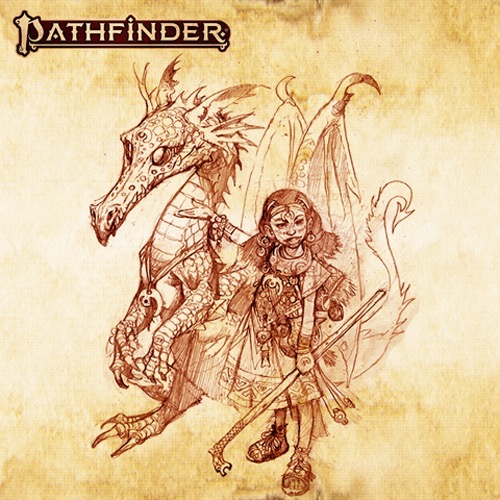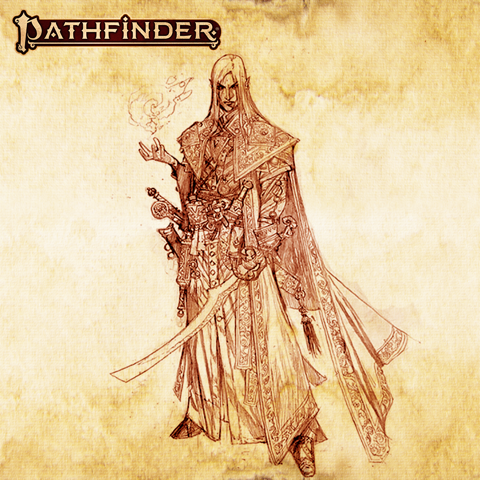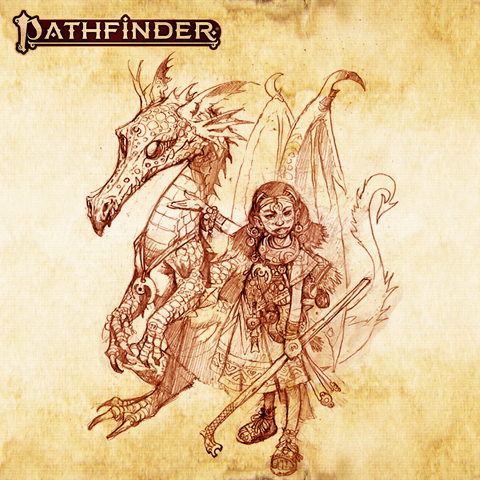Hi, folks! Logan here. We’ve had some time to look over the survey results and messageboard posts after the Secrets of Magic playtest concluded, and had team discussions about potential changes ahead. Thanks to everyone who participated in the playtest, playing characters, finding problems, taking surveys, and giving feedback! We wanted to give you a bit of an idea of the direction we’re looking at taking the magus and summoner for the final book. Not everything here is set in stone, though. We still have rewrites to do, more internal conversations to have, and additional data to look at. There are also hundreds of little things we’ll be changing, from individual feats to story elements—this blog is just hitting the main points. And, hey, if you stick around to the end of the blog, we have an extra treat for you!
Seltyiel, the iconic magus, sketch by Wayne Reynolds
Magus
Much of the feedback on the magus indicated that it felt too restrictive and too random. The class could be quite powerful, but required really specific play patterns and choices to get there. We don’t want a class that can do a huge nova attack if you stack your true strikes correctly but isn’t satisfying for doing much else. Our focus for further magus development will be adding more varied strategies, making the action economy less difficult to deal with, and giving more clear paths to build toward what you want your magus to do.
Striking Spell: This ability, unsurprisingly, was the focus of much of the conversation from the playtest. In surveys, it was rated as being interesting, but not powerful enough. It was also rated as being difficult to understand. Players noted that it could be frustrating to spend your whole turn casting a Striking Spell spell, then miss with the Strike. Even having more chances at it didn’t take out the sting of needing to wait for another turn to try again. Often, even if the spell came off later, the magus had missed enough opportunities that it didn’t seem worth it.
Making changes to Striking Spell won’t be straightforward, and we still need to do a lot of experiments to find something that’s fully satisfying. One of the major drivers for the playtest version was making it highly flexible to allow for using a wide variety of spells (compared to, say, Eldritch Shot) and let you use your stored spell with other abilities (like Flurry of Blows or Power Attack). Ultimately, these came at the expense of having a straightforward, solid special ability that was dependable. And it also meant that many paths to doing cool things required multiclassing, which leaves the class itself feeling lackluster.
We know for sure that we want to restructure the action to make its presentation clearer. We’re also going away from using a special benefit that relies on a critical hit, as that led to the ability feeling too random and giving too strong an incentive to load up on true strike and put all your eggs in one basket. For actual effects of the ability, there are a lot of options on the table, such as having a stored spell with a spell attack roll not increase your multiple attack penalty, or going a bit farther and using the same roll for your Strike and spell (similar to Eldritch Shot), or having some type of buff you gain while you have a stored spell so you don’t necessarily want to use it right away. Some changes might require Striking Spell to no longer be at-will, so using it is a more impactful moment rather than repetitive. Lowering its frequency, of course, requires some other tools to give your other turns that magus flavor. We’re still workshopping ideas on that front.
Spells: The spell progression for magus has a total of four slots maximum. We knew the spell progression would also be a major topic of discussion. Players were pretty divided among which path to take, with about 40% of survey respondents happy with the playtest path, and a wide variety of opinions about alternatives with no clear victor. One of the common notes we saw was that the four slots didn’t allow for many interesting or fun utility spells, but that the Martial Caster feat brought some back in. To that end, we’re looking at adding a class feature similar to Martial Casting around 7th level. That will link to our next topic...
Magus Synthesis: Much of the discussion about the magus suggested slide casting felt like a mandatory pick. In the surveys, while slide casting was chosen the most, the selections were much more varied than we expected. And beyond that, shooting star had the best numbers on the “fun scale.” With the intention to make the action economy of Striking Spell more player-friendly, we also want to make the synthesis options more distinctly focused on certain playstyles rather than one appearing like a mandatory choice for action economy purposes. There will likely be more syntheses coming, too, as we add options for the final book.
We intend to give more of a story hook to syntheses, since they’re currently a bit dry compared to similar options in other classes. These will likely also come with some extra benefits that give a bit of a leg up to certain playstyles, such as adding more spells to your spellbook or influencing what you get from the Martial Caster benefit, as noted above. We’re also planning to change the name to avoid confusion with the summoner, who has had a synthesis option since 1st Edition. Finally, we heard you when you said Raise a Tome doesn’t work with the syntheses, and will be fixing that.
Spell Proficiency: This part is pretty straightforward. It was noted that the magus has a slower spell attack roll and spell DC progression than the champion or monk can get with their focus spells. The magus will be getting a faster progression.
Battle Spells: The magus potency spell wasn’t that popular. People have been asking for a special attack spell as a focus spell instead, particularly a 1-action spell. We had avoided that for two reasons: first, if the spell is strong, fights can end up really repetitive, and second, we had intended for cantrip choice and their use to be an important part of playing a magus. Cantrips ended up not feeling like a good enough value to be worth using with Striking Spell, though. The battle spell will be changing from magus potency, but the specifics aren’t settled yet. It might be an attack spell with a Striking Spell benefit; it might be based on your synthesis if those would benefit from being differentiated in this way—this depends a lot on how the rest of the class shakes out and we won’t have a clear answer for a while yet.
And now I’ll turn this over to Mark to talk about the summoner!
New iconic summoner and her dragon, sketch by Wayne Reynolds
Summoner
Hi everyone, Mark Seifter here for a post-playtest report for the summoner class. First of all, thanks to everyone who participated in the summoner playtest, running games, posting playtest results and analysis, answering surveys, and more! The summoner class had quite a bit of online interaction this time around, and there were a lot of interesting and cogent discussions with many good points made by folks with differing opinions.
Overall people really liked the summoner, with the second highest overall approval after the swashbuckler, but there were also some pitfalls, from small to moderate, that people were looking to see fixed, and they all interact in different ways, which makes it a little harder than for the magus to go into great detail on what changes will happen. Finding a fix for a new issue might require revisiting our decision for one we had an idea of how to solve.
Main Takeaways: Some outcomes are clear. We’re strongly leaning toward changing Act Together to a variable-action activity, allowing either the summoner or eidolon to use a 1-, 2-, or 3-action activity and the other to use a single action. The summoner will be getting proficiency increases to spell attack roll and spell DC sooner, just like the magus. We also want to allow more customization of your eidolon at 1st level without loading up too many choices to make, so we’re leaning towards more evolutions being available at 1st level and giving you a free evolution to choose from at 1st level. We’re also looking into a few other avenues to potentially increase versatility—but there’s an upper limit on how complex the class can be, so there’s likely to be a process where we add and subtract things until we’re satisfied. As such, I don’t want to get too specific in case it changes.
Eidolon Types: We plan to increase from the four eidolon types presented here to between eight and 10 eidolon types in the final version. Expect them to be chosen from among the ranks of the eidolon types mentioned, but not presented, in the playtest, such as fey and demon eidolons.
Spellcasting: One issue that had a lot of discussion was how to handle spellcasting, whether to keep it the same, remove spell slots for other options like eidolon abilities or focus spells, increase spell slots and weaken the eidolon’s offense, or take a different approach. Based on the plurality of responses in favor of keeping the spellcasting the way it currently works, we are leaning towards that option. We’ve seen some positive playtest results with regards to diverse spell selection and usage.
Synthesis: There was a lot of feedback on the Synthesis feat that allowed you to merge with your eidolon; it was popular but many folks said that being an option you choose each time you Manifest rather than mandatory didn’t fulfill the fantasy and that the ability to use both options caused it to have quite a few restrictions it might not need otherwise. Right now we are leaning towards changing the feat’s name and flavor to be clear that it is meant for an optional ability, and then make the synthesist a class archetype in a later book, with trade-offs based around having only the option to merge with the eidolon, not to Manifest it normally.
Incarnate Spell Preview
That’s a lot to read, so let’s finish things off with a preview of a new type of “mega summoning” wherein you summon a powerful thematic creature that sticks around briefly and has a big impact! This is still early in the process, so any elements of this, including names, might still change. And because this is just a preview, don’t go trying to use this in Pathfinder Society! Though if I were your home GM and you gave me some cookies, I’d allow it, personally.
Incarnate Trait
A spell with the incarnate trait operates as follows, rather than conjuring a minion with the summoned trait and allowing you to direct its actions. When summoned, the incarnate creature takes its Arrive action. At the end of your next turn, the summoned creature can either Step, Stride, or take the action for another movement type it has (such as Climb or Burrow), and then takes its Depart action. Then the spell ends.
An incarnate spell directs its effects away from you and your allies as much as possible. The incarnate spell’s effect is not quite a creature. It can’t take any other actions, nor can it be targeted or harmed by Strikes, spells, or other effects unless they would be able to target or end a spell effect (such as dispel magic). It has a size for the purposes of determining its placement for effects, but does not block movement. If applicable, its effects use your spell DCs and spell attack roll modifier.
Summon Vengeful Dead — Spell 7
Incarnate, Necromancy
Traditions divine, occult
Cast [three-actions] material, somatic, verbal
Range 100 feet
Duration until the end of your next turn
You channel the forces of undeath to briefly call forth an amalgam of the vengeful dead slain by your enemies and allies alike. This amalgam manifests as a large tornado of insubstantial, howling faces. It occupies the space of a Huge creature and has a Speed of 60 feet.Arrive (negative) All enemy creatures within a 60-foot emanation must attempt Fortitude saves.
- Critical Success The creature is unaffected
- Success The creature is drained 1.
- Failure The creature is drained 2.
- Critical Failure The creature is drained 3.
Depart (emotion, fear, mental) The vengeful dead lets out an anguished scream. All your enemies within a 100-foot emanation must attempt Will saves.
- Critical Success The creature is unaffected.
- Success The creature is frightened 2.
- Failure The creature is frightened 3.
- Critical Failure The creature is frightened 3. It’s also fleeing for 1 round or until it is no longer frightened, whichever comes first.
regards,
Logan Bonner
Pathfinder Lead DesignerMark Seifter
Design Manager
Secrets of Magic Playtest Aftermath
Monday, November 2, 2020










